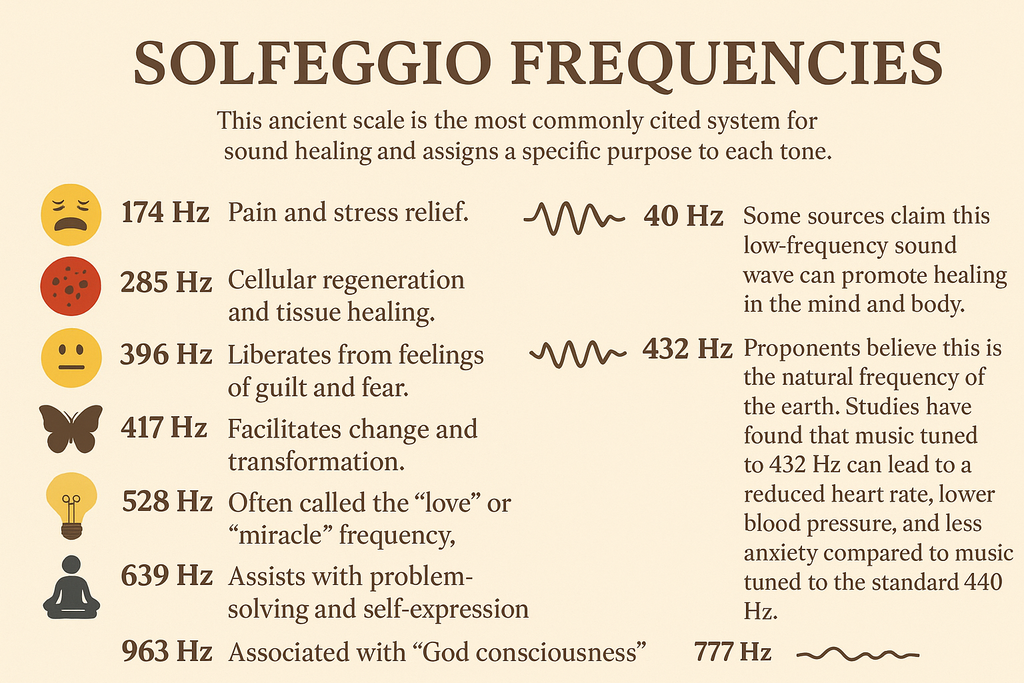
Solfeggio Frequencies: Unlocking Ancient Tones for Modern Well-being

Solfeggio Frequencies: Unlocking Ancient Tones for Modern Well-being
In a world constantly buzzing with noise and demands, the quest for inner peace and holistic well-being often leads us to explore ancient practices and forgotten wisdom. Among these, the concept of sound healing has resonated through centuries, suggesting that specific auditory vibrations can influence our physical, mental, and spiritual states. Within this fascinating realm, Solfeggio Frequencies emerge as a captivating subject—a series of ancient musical tones believed to possess profound healing properties.
This comprehensive blog post delves into the intriguing world of Solfeggio Frequencies, exploring their rich history, the individual characteristics and purported benefits of each tone, and critically examining the scientific perspectives surrounding their efficacy. Join us as we uncover how these ancient sounds might offer a pathway to enhanced well-being in our modern lives.
The Ancient Roots of Solfeggio Frequencies
The story of Solfeggio Frequencies is deeply intertwined with the history of Western music and spiritual practices. These tones are most commonly associated with the Gregorian Chants, a form of monophonic sacred song of the Roman Catholic faith that flourished in the 9th and 10th centuries [1]. While evidence suggests the existence of these frequencies dates back to early Biblical times, their formalization is often credited to a Benedictine monk named Guido d’Arezzo in the 11th century [1].
Guido d’Arezzo is believed to have introduced a musical scale that formed the basis of the Solfeggio frequencies. His work included a musical rendition of the Hymn to St. John the Baptist (Ut queant laxis), an 8th-century poem. The first syllables of each line of this hymn—Ut, Re, Mi, Fa, Sol, La—correspond to the original six Solfeggio tones, which are the precursors to the modern Do-Re-Mi scale [1].
These ancient frequencies were largely forgotten for centuries, particularly with the rise of the Twelve-Tone Equal Temperament scale around the 16th century. This new tuning method gradually replaced the older "Just Intonation" system, which utilized the six-tone Solfeggio. Many musicologists argue that the 12-tone scale, while providing greater flexibility for complex compositions, lacked the inherent clarity and smoothness of the ancient 6-tone scale [1]. The historical context of the Middle Ages and significant events like the Great Schism of 1054 also contributed to the loss and obscurity of these frequencies [1]. It wasn't until the 1970s that these lost Solfeggio frequencies were reportedly rediscovered, sparking renewed interest in their potential applications for healing and well-being [1].
The Solfeggio Frequencies Explained
The Solfeggio scale, originally consisting of six tones, has been expanded to include nine primary frequencies, each associated with specific physical, emotional, and spiritual benefits. While the scientific community has not definitively validated these claims, they form the cornerstone of Solfeggio-based sound therapy. The table below provides a comprehensive overview of these nine frequencies and their purported benefits, as described by proponents of this healing modality [3].
174 Hz: Believed to act as a natural anesthetic, relieving pain and stress. It is also associated with a sense of security and improved concentration [3].
285 Hz: Thought to influence energy fields, sending messages to restructure damaged organs and tissues. It is linked to cellular regeneration and immune system support [3].
396 Hz: Associated with liberating guilt and fear, helping to clear negative beliefs and subconscious blockages. It is often used to ground and anchor individuals in the present moment [1], [3].
417 Hz: Believed to facilitate change and undo situations with negative outcomes. It is said to cleanse traumatic experiences and clear destructive influences of past events [1].
528 Hz: Often called the "love frequency" or "miracle tone," this frequency is associated with transformation, miracles, and even DNA repair. It is also linked to increased life energy, clarity of mind, awareness, creativity, and inner peace [1], [3].
639 Hz: This frequency is said to enhance communication, love, tolerance, and understanding, thereby improving relationships. It is believed to promote harmony and connection with others [1].
741 Hz: Associated with the power of self-expression, leading to a healthier and more stable life. It is also linked to cleansing the body of toxins and electromagnetic radiation [1].
852 Hz: Believed to awaken intuition and enable a return to spiritual order. It is associated with a higher level of awareness and connection to the divine [1].
963 Hz: The highest of the primary Solfeggio frequencies, this tone is associated with awakening any system to its original, perfect state. It is connected with the Crown Chakra and is often linked to a sense of oneness and connection to the universe [3].
It is worth noting that another frequency, 432 Hz, is often discussed in the context of sound healing and is sometimes referred to as a Solfeggio frequency, although it is not part of the original or expanded scales. Proponents claim that 432 Hz music is more in harmony with nature and has a calming and relaxing effect on the body, making it beneficial for sleep and overall well-being [3].
The Science Behind the Sound: Healing or Pseudoscience?
The claims surrounding Solfeggio Frequencies are undoubtedly compelling, but what does the scientific community have to say? While anecdotal evidence and the popularity of sound therapy continue to grow, it is crucial to approach this topic with a discerning mind. The reality is that rigorous, peer-reviewed scientific research specifically on Solfeggio Frequencies is limited [2].
That being said, the idea that sound can influence biological processes is not without precedent. The medical field has long utilized sound waves in technologies like ultrasound for diagnostic imaging. Furthermore, the broader field of sound therapy has shown promise in various applications. For instance, the Tomatis method, developed by French doctor Alfred Tomatis, uses sound and music to address hearing loss, learning disabilities, and even autism, with some of his work reportedly involving Gregorian chants [1].
Some studies have suggested that music and specific sound frequencies can have a positive impact on the human body. Research has indicated that music can reduce anxiety, enhance self-esteem, and improve interpersonal skills [1]. Other studies have found that music can positively affect the autonomic nervous system and endocrine system, leading to stress reduction [1]. For example, the 528 Hz frequency has been shown in some research to support cortisol reduction, which is the body's primary stress hormone [3].
However, it is important to distinguish between the well-documented effects of music on the brain and the specific, targeted healing claims attributed to each Solfeggio frequency. While the former is supported by a growing body of evidence, the latter remains largely in the realm of speculation and personal experience. As one article aptly puts it, Solfeggio Frequencies are an "intriguing yet largely unverified tool" [2]. Until more robust scientific data emerges, it is best to view these frequencies as a potential aid for relaxation and stress relief, rather than a proven medical treatment.
How to Incorporate Solfeggio Frequencies into Your Life
Given the potential benefits and the growing interest in Solfeggio Frequencies, many individuals are exploring ways to integrate these tones into their daily routines. While scientific validation is still evolving, the anecdotal evidence suggests that incorporating these frequencies can contribute to a sense of calm, focus, and overall well-being. Here are some common approaches:
Meditation and Relaxation: Listening to Solfeggio Frequencies during meditation can deepen the experience, helping to quiet the mind and promote a state of profound relaxation. Many guided meditations and sound bath experiences now incorporate these specific tones.
Sleep Improvement: Certain frequencies, particularly 528 Hz and 432 Hz, are often recommended for improving sleep quality. Playing these frequencies softly in the background before or during sleep may help calm the nervous system and facilitate a more restful night [3].
Background Music for Focus and Creativity: Some individuals find that listening to Solfeggio Frequencies while working or engaging in creative tasks can enhance concentration and stimulate innovative thinking. The gentle, repetitive nature of these tones can create an environment conducive to deep work.
Personal Exploration: The most effective way to determine the impact of Solfeggio Frequencies is through personal experimentation. Many online platforms offer recordings of individual frequencies or combinations thereof. Pay attention to how different tones make you feel and integrate those that resonate most with your personal well-being goals.
It is important to approach this practice with an open mind, focusing on the subjective experience of relaxation and well-being rather than expecting miraculous cures. Consistency and a receptive attitude are key to experiencing any potential benefits.
Conclusion
Solfeggio Frequencies represent a fascinating intersection of ancient wisdom, musical tradition, and the ongoing human quest for healing and well-being. From their origins in Gregorian Chants to their modern-day rediscovery, these tones offer a unique perspective on the power of sound. While the scientific community continues to explore and validate the specific claims associated with each frequency, the anecdotal evidence from countless individuals suggests a profound potential for relaxation, stress reduction, and emotional balance.
Whether you are seeking to deepen your meditation practice, improve your sleep, or simply explore new avenues for personal well-being, Solfeggio Frequencies offer an accessible and intriguing path. We encourage you to approach them with an open mind and a healthy dose of curiosity, allowing their ancient vibrations to guide you on your journey toward holistic harmony.
References
[1] Solfeggio Frequencies - History, Science & How They Work. (n.d.). MindVibrations.
[2] Taras, Z. (2025, March 21). Solfeggio Frequencies: Healing Tones or Pseudoscience? HowStuffWorks.
[3] The Benefits of the 9 Solfeggio Frequencies. (2023, May 31). Oura Ring Blog.


